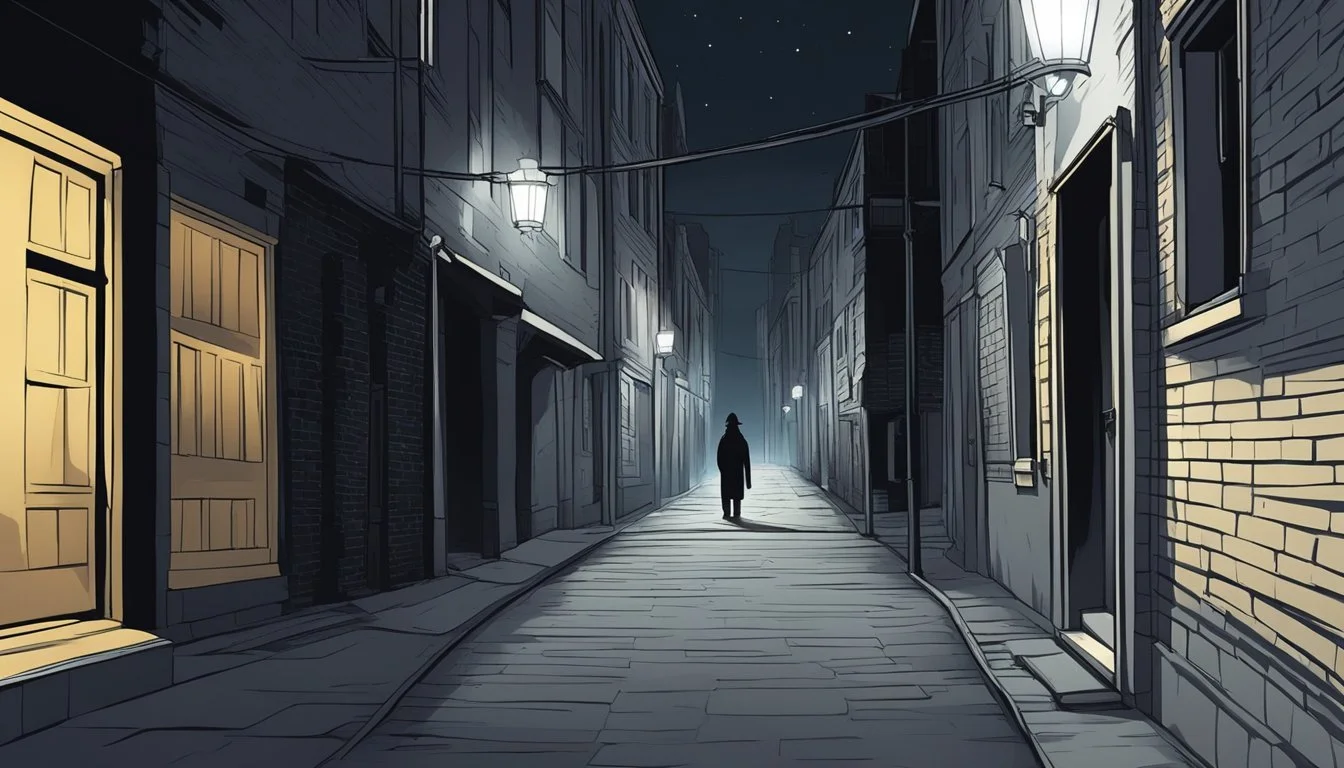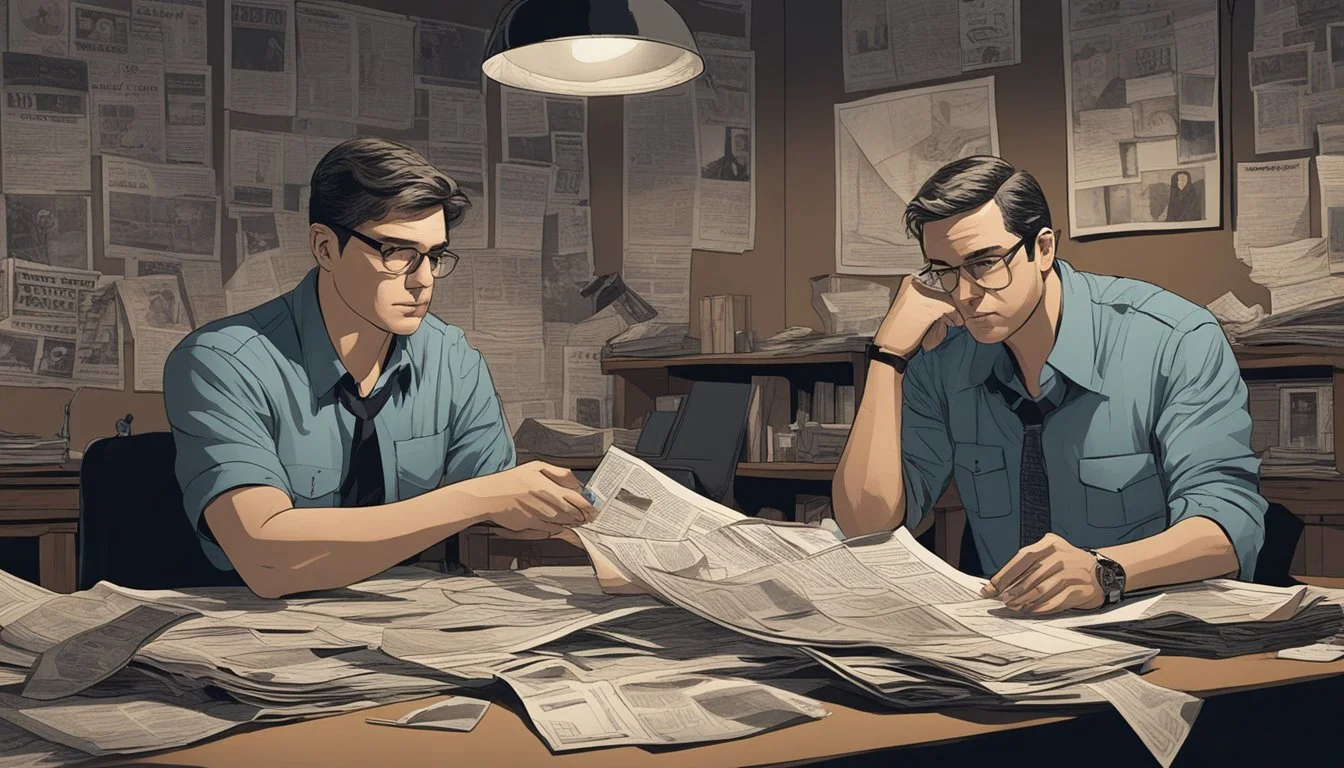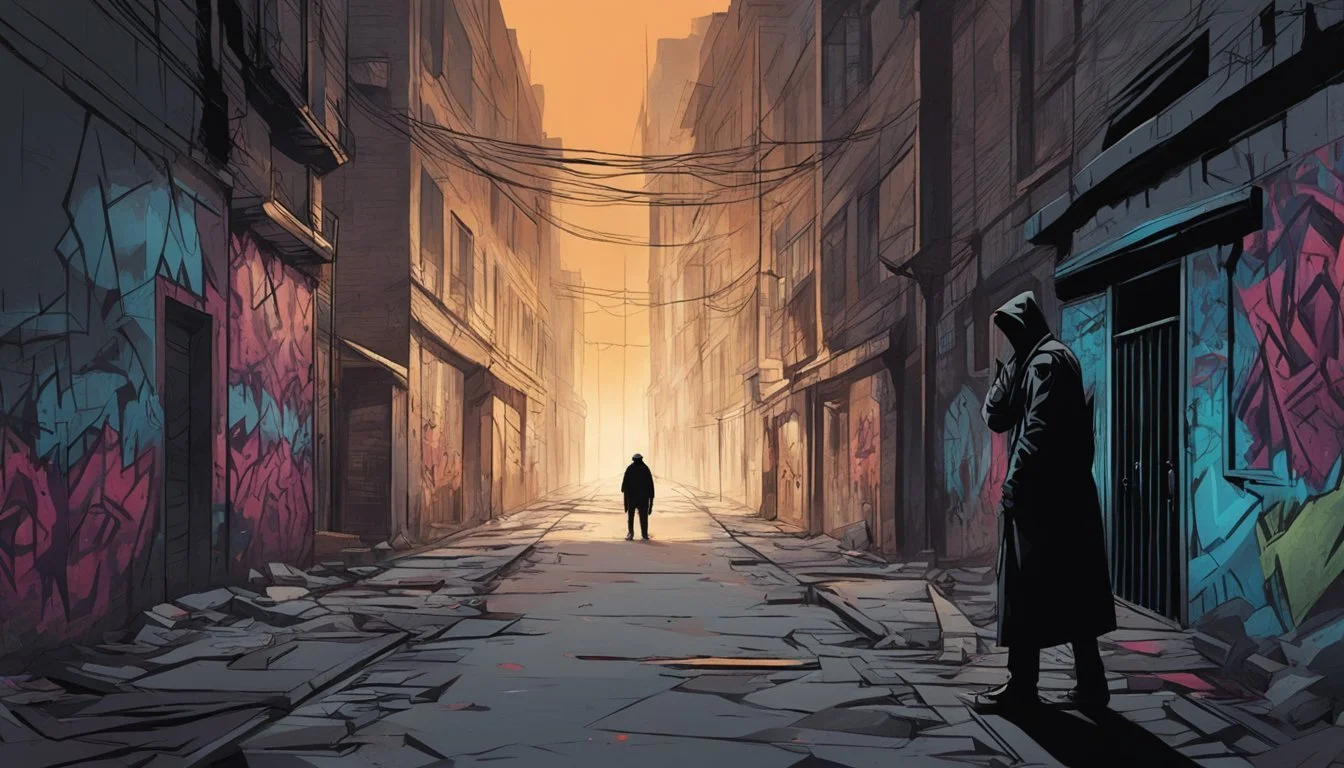Angels of Death: How Buono and Bianchi Became the Hillside Stranglers
A Chilling Tale of Serial Killers in Los Angeles
In the late 1970s, Los Angeles found itself gripped by terror as a series of brutal murders unfolded across the city. The perpetrators, later dubbed the Hillside Stranglers, left a trail of bodies in the hills surrounding the sprawling metropolis. These killers, cousins Angelo Buono and Kenneth Bianchi, would go on to rape, torture, and murder at least 10 women and girls between October 1977 and February 1978.
The Hillside Stranglers case shocked the public with its depravity and the seemingly random nature of the victims. Buono and Bianchi's crimes spanned a wide range of targets, from young girls to adult women. Their method of disposing of bodies in the hills gave rise to their infamous moniker and added to the fear that permeated the city.
As the investigation unfolded, law enforcement initially believed they were dealing with a lone killer. The revelation that two men were working in tandem added a chilling new dimension to the case. The story of how these two cousins became the Hillside Stranglers is a disturbing tale of shared psychopathy and escalating violence that would leave an indelible mark on criminal history.
Origins of the Hillside Strangler
Angelo Buono and Kenneth Bianchi's transformation into the notorious Hillside Stranglers began with troubled childhoods and a path of increasing criminality. Their backgrounds set the stage for their eventual descent into serial murder.
Early Lives of Buono and Bianchi
Kenneth Bianchi was born on May 22, 1951, in Rochester, New York. His birth mother, an alcoholic prostitute, gave him up for adoption at three months old. Frances Bianchi and her husband, a foundry worker, adopted Kenneth.
Bianchi's early life was marked by instability and behavioral issues. He struggled with relationships and showed signs of manipulation from a young age.
Angelo Buono, Bianchi's older cousin, had a different but equally troubled upbringing. Born in Rochester, he moved to California as a teenager. Buono displayed a deep-seated hatred towards women early on.
Path to Becoming Serial Killers
Buono's criminal activities began with car theft and escalated to assault. He later became involved in pimping, exploiting and abusing women.
Bianchi moved to Los Angeles in 1975, reconnecting with his cousin Buono. Their toxic relationship and shared misogyny fueled their criminal endeavors.
The cousins started working together, initially in Buono's auto upholstery business. They soon branched out into more sinister activities, including impersonating police officers to lure victims.
Their criminal partnership escalated rapidly. By 1977, they had begun their killing spree, targeting young women and girls in the Los Angeles area.
The Killing Spree
Angelo Buono and Kenneth Bianchi embarked on a brutal murder spree that terrorized Los Angeles from 1977 to 1978. The cousins targeted young women, subjecting them to unspeakable torture before strangling them to death.
First Known Victim
Yolanda Washington, a 19-year-old sex worker, became the first known victim of the Hillside Stranglers on October 17, 1977. Her nude body was discovered near the Forest Lawn Memorial Park in Los Angeles. The autopsy revealed she had been raped and strangled.
This murder set the pattern for the killings that would follow. Buono and Bianchi specifically chose vulnerable young women as their targets. They often posed as police officers to gain their victims' trust.
Pattern of Murders
The Hillside Stranglers followed a chilling pattern in their crimes:
Abduction: They lured or forcibly took victims into their vehicle
Torture: Victims endured sexual assault and various forms of abuse
Strangulation: The primary method of killing
Body disposal: Victims' bodies were dumped in hillside areas
Most victims were found nude, adding to the shock and horror of their discoveries. The killers' method of strangulation left distinct marks on the victims' necks.
Escalation of Violence
As the killing spree continued, Buono and Bianchi's crimes became increasingly brutal. They expanded their victim pool beyond sex workers to include young women from various backgrounds.
In one particularly horrific case, they abducted two schoolgirls from Glendale. The cousins held their victims captive for extended periods, subjecting them to prolonged torture before finally ending their lives.
The escalating violence and frequency of murders intensified the fear gripping Los Angeles. Law enforcement faced mounting pressure to catch the killers as the body count rose.
Investigation and Arrest
The Hillside Strangler case baffled Los Angeles law enforcement for months. Detectives pieced together clues from crime scenes and witness accounts to track down the killers.
Key Evidence Discovery
Police found crucial evidence at various dump sites. Tire tracks and shoe prints near victims' bodies provided valuable leads. Fibers and hair samples collected from the women matched those found in suspect vehicles.
Investigators noted similarities in how victims were restrained and killed. This suggested the work of serial offenders rather than isolated incidents. Autopsy reports revealed a consistent pattern of sexual assault and strangulation.
Witness statements described suspicious men posing as police officers. This tactic helped the killers lure unsuspecting women into their vehicle.
The Capture of Bianchi and Buono
Kenneth Bianchi's arrest in Bellingham, Washington marked a turning point. Local police caught him for the murders of two college students in January 1979.
Los Angeles detectives quickly linked Bianchi to the Hillside Strangler cases. Under interrogation, he implicated his cousin Angelo Buono as his accomplice.
Investigators found damning evidence in Buono's auto upholstery shop. This included jewelry belonging to victims Becky Spears and Deborah Noble.
Police arrested Buono in October 1979. The cousins' reign of terror finally ended, bringing relief to a frightened city.
Trial and Conviction
The legal proceedings against Angelo Buono and Kenneth Bianchi for the Hillside Strangler murders were extensive and complex. Their trial and subsequent conviction marked a significant chapter in California's criminal justice history.
Legal Proceedings
The trial of Angelo Buono began in November 1981 and lasted over two years. It became one of the longest and most expensive criminal cases in Los Angeles history. Prosecutors presented evidence from crime scenes and witness testimonies to build their case.
Kenneth Bianchi, who had been arrested separately in Washington state, agreed to testify against his cousin Buono as part of a plea bargain. His testimony proved crucial in securing a conviction. The trial featured graphic details of the murders and sexual assaults committed by the pair.
Sentencing
On November 18, 1983, Angelo Buono was found guilty of nine counts of murder. The jury deliberated for two weeks before reaching their verdict. Buono received a sentence of life imprisonment without the possibility of parole.
Kenneth Bianchi had already pleaded guilty to five murders in California and two in Washington. He also received life sentences for his crimes. Both men were sent to separate maximum-security prisons to serve their terms.
The convictions brought a sense of closure to the victims' families and the community that had been terrorized by the Hillside Stranglers. Their case has since been featured in numerous documentary series examining infamous serial killers.
Modus Operandi
Angelo Buono and Kenneth Bianchi employed specific tactics to abduct and murder their victims. Their methods evolved as they grew more confident in their crimes.
Abduction and Deception
Buono and Bianchi primarily targeted sex workers and young women. They often posed as police officers to gain trust and compliance from their victims. This tactic allowed them to approach women without arousing suspicion.
The cousins cruised Los Angeles streets in Buono's car, looking for potential targets. They would flash fake badges and claim to be conducting vice operations. Unsuspecting victims would then willingly get into their vehicle.
In some cases, they approached women at bus stops or other public places, offering rides. Their seemingly official status made it easier to lure victims away from populated areas.
Methods of Killing
Once they had a victim in their control, Buono and Bianchi would take them to Buono's auto upholstery shop or his home. There, they subjected their victims to brutal torture and sexual assault.
The cousins typically killed their victims through strangulation. They used various ligatures, including cords and pantyhose. This method left distinctive ligature marks on the victims' necks.
Some victims were also injected with cleaning solutions or subjected to electric shocks. These sadistic acts were part of the prolonged torture process before the final killing.
After murdering their victims, Buono and Bianchi would dump the bodies on hillsides around Los Angeles. This disposal method led to their infamous "Hillside Strangler" moniker.
Victimology
The Hillside Stranglers targeted primarily young women and girls, with victims ranging from 12 to 28 years old. Their methods of abduction and murder revealed a disturbing pattern of escalating violence and cruelty.
Profiles of the Victims
Buono and Bianchi's victims included prost*tutes, teenage runaways, and middle-class girls. Yolanda Washington, 19, was their first known victim in October 1977. Judy Miller, only 15, was abducted while hitchhiking.
Dolores Cepeda and Sonja Johnson, both 14, were kidnapped together after school. Kristina Weckler, a 20-year-old honors student, was another tragic casualty.
The killers often targeted vulnerable individuals, exploiting their trust or desperation. Some victims were lured with false promises of work or rides.
Social Impact
The murders sparked widespread fear in Los Angeles, particularly among young women. Many altered their daily routines and avoided going out alone, especially at night.
Parents became more protective of their children, imposing stricter curfews and supervision. Schools and community organizations held safety awareness programs.
The targeting of prost*tutes highlighted the risks faced by sex workers and sparked discussions about their protection. The cases of teenage victims like Cepeda and Johnson shocked the public, emphasizing the vulnerability of young girls.
Media coverage of the murders was extensive, keeping the community on high alert but also potentially sensationalizing the crimes.
Psychological Aspects
The Hillside Stranglers case reveals complex psychological factors that drove the killers' actions. Examining their mental states and relationship dynamics provides insight into the motivations behind their crimes.
Personality Disorders
Kenneth Bianchi exhibited traits consistent with antisocial personality disorder. He displayed a lack of empathy, manipulative behavior, and a history of pathological lying. Bianchi's adoptive mother described him as attention-seeking and prone to tantrums from a young age.
Angelo Buono demonstrated narcissistic tendencies and a violent temperament. He had a history of abusive relationships and showed little remorse for his actions. Both men struggled with impulse control and a need for dominance over others.
Psychologists noted that Bianchi attempted to fake dissociative identity disorder during his trial. This manipulative tactic aimed to avoid responsibility for his crimes.
Influence of Dual Perpetrators
The partnership between Buono and Bianchi intensified their violent impulses. Their shared fantasies and mutual encouragement led to escalating brutality in their crimes. Buono, the older cousin, exerted a strong influence over Bianchi.
Experts believe the duo's relationship created a "folie à deux" scenario, where shared psychotic beliefs reinforced their criminal behavior. This dynamic allowed them to rationalize their actions and push each other to commit increasingly heinous acts.
The cousins' collaboration enabled them to carry out more sophisticated crimes than they likely would have individually. Their combined skills in manipulation and violence made them a particularly dangerous team.
Aftermath and Legacy
The Hillside Stranglers case left an indelible mark on Los Angeles and the broader cultural landscape. Buono and Bianchi's crimes reshaped public perceptions of serial killers and influenced law enforcement practices.
Prison Life
Kenneth Bianchi remains incarcerated at Washington State Penitentiary, serving multiple life sentences. He spends his days in relative isolation, with limited contact with other inmates and staff.
Angelo Buono died in prison on September 21, 2002, at the age of 67. He succumbed to a heart attack while serving his life sentence at Calipatria State Prison.
Both men were denied parole multiple times during their incarceration. Their confinement was characterized by strict security measures due to the notoriety of their crimes.
Cultural Impact
The Hillside Stranglers case significantly influenced popular culture and true crime media. Numerous books, documentaries, and films have explored the chilling details of their crimes.
The Los Angeles Public Library maintains extensive archives related to the case, serving as a resource for researchers and true crime enthusiasts.
The case drew comparisons to other notorious California serial killers, including Richard Ramirez, known as the Night Stalker. It highlighted the vulnerability of young women in urban areas and sparked discussions about personal safety.
The Hillside Stranglers' modus operandi of posing as police officers led to increased public scrutiny of law enforcement encounters and heightened awareness of potential imposters.
Comparisons and Contrasts
The Hillside Stranglers shared commonalities with other notorious serial killers, yet possessed distinctive traits that set them apart. Their methods and motivations aligned with some infamous murderers while diverging significantly from others.
Similarities to Other Serial Killers
Angelo Buono and Kenneth Bianchi exhibited behaviors reminiscent of other serial killers. Like Richard Ramirez, the Night Stalker, they terrorized Los Angeles with a series of brutal murders. Both duos targeted women and used vehicles to abduct victims.
The Hillside Stranglers and Ramirez shared a penchant for sexual violence. They all left their victims' bodies in outdoor locations, creating a pattern that alarmed the public.
Similar to David Wood, Buono and Bianchi operated as a team. This partnership dynamic is relatively rare among serial killers, who often work alone.
Unique Aspects of the Hillside Stranglers
Buono and Bianchi's familial relationship as cousins set them apart from most killer duos. Their use of fake badges to lure victims was a distinctive tactic not commonly employed by other serial murderers.
The Hillside Stranglers targeted a wide age range, from young teenagers to adult women. This broad victim profile differed from killers who focused on specific age groups.
Their crimes spanned multiple jurisdictions, complicating the investigation. Detective Bob Grogan noted the challenges this posed for law enforcement agencies.
The Eagle Rock area became a focal point in their crime spree, distinguishing their geographical pattern from other Los Angeles-based killers who operated more widely across the city.
Media Representation
The Hillside Stranglers case captured significant media attention, leading to numerous portrayals in documentaries, films, and true crime literature. These works explored the killers' backgrounds, their crimes, and the investigation that ultimately led to their capture.
Documentary and Film
Several documentaries have examined the Hillside Stranglers case. "The Hillside Strangler" (2004) delved into the investigation and trial of Kenneth Bianchi and Angelo Buono. The film "The Case of the Hillside Stranglers" (1989) dramatized the events, focusing on the detectives' pursuit of the killers.
True crime series like "Born to Kill?" and "Twisted" have featured episodes on Bianchi and Buono. These programs often included crime scene footage and interviews with investigators, providing viewers with a detailed look at the case.
Journalism and True Crime Books
Journalists extensively covered the Hillside Stranglers' killing spree, keeping the public informed as the investigation unfolded. The media's use of the term "Hillside Strangler" initially suggested a single perpetrator, later changing to "Stranglers" when two killers were identified.
Several true crime books have been written about the case. Darcy O'Brien's "Two of a Kind: The Hillside Stranglers" (1985) offered an in-depth analysis of Bianchi and Buono's backgrounds and crimes. Ted Schwarz's "The Hillside Strangler: A Murderer's Mind" (1981) focused on the psychological aspects of the killers.
These works often explored the serial killers' motivations and the impact of their crimes on Los Angeles during their reign of terror.
The Stranglers' Personal Lives
Angelo Buono Jr. and Kenneth Bianchi led complex personal lives before their infamous killing spree. Their family dynamics and early careers shaped the men who would become known as the Hillside Stranglers.
Family and Relationships
Angelo Buono Jr. experienced multiple marriages and divorces. He fathered several children but struggled to maintain stable relationships. Buono operated an auto upholstery shop, which became a key location in the killings.
Kenneth Bianchi, Buono's cousin, moved from Rochester to Los Angeles in 1976. He lived with Buono for a time and worked various jobs, including as a security guard.
The cousins' close relationship would prove deadly as they began to collaborate on their crimes.
Life Prior to Killings
Before the murders, Buono and Bianchi led seemingly ordinary lives. Buono ran his upholstery business and interacted with customers regularly.
Bianchi held a series of jobs and attempted to join the Los Angeles Police Department. He failed the psychological examination.
Both men had histories of petty crimes and antisocial behavior. These tendencies escalated dramatically when they joined forces in late 1977.
Their backgrounds as working-class men allowed them to blend into society, making their crimes even more shocking when discovered.



